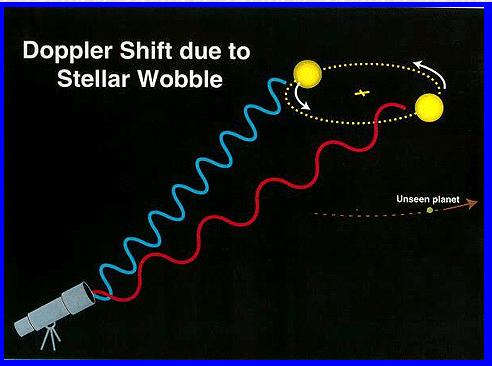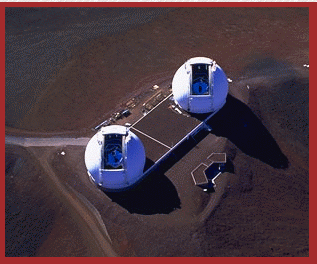 Lesson 9:
Lesson 9:
 Other Worlds, Other Life
Other Worlds, Other Life
|
 9.4
9.4
 Strategies Of Searching
Strategies Of Searching
 |
Direct Observations
|
 |
Direct observations can take several forms. One is the astrometry discussed previously,
where an attempt is made to precisely measure a star's position at various times, so that any
motion induced by a companion can be seen. This has not proved successful in locating planets.
Another direct observation technique is monitoring the light output of a star, in hopes of
catching a transit by a planet. This may work if we are in the planet's orbital plane,
if the star's output is sufficiently constant and there are no large starspots.
This technique does appear to have worked once so far, and is expected to be
used more in the future. Eventually, giant adaptive mirrors in space should be capable
of imaging exoplanets directly.
Recently astronomers using the Hubble Space Telescope captured this image of a planet
orbiting Gliese 229A. It is about the size of Jupiter and lies 44 AU from the star.
(Pluto is 40 AU from our Sun.)
An unquestionable direct observation of an extraterrestrial or any extraterrestrial
artifact would be of extreme interest.
 |
Spectroscopy
|
 |
Spectroscopy has been an extremely effective tool in astrophysics, whereby we can
deduce temperature and pressure conditions, magnetic fields and other parameters of
interest in stars and galaxies far, far away. This technique has been used,
via Doppler shifting of spectral lines, to detect almost all of the exoplanets which
have been found to date. But the signals are small and deeply buried in the noise; it may be
difficult to improve this technique enough to detect terrestrial planets. The game
is still afoot.
 |
 |
Figure 9.4.3 Doppler shift of starlight caused by planetary
Doppler shift of starlight caused by planetary
companion. As the planet moves away from the observer, it
pulls the star with it and the star's light is reddened. When
the planet moves toward the observer, the star's light is
shifted toward the blue end of the spectrum.
|
 |
Interferometry |
 |
Interferometry is a technique which has been used for decades in radio astronomy,
where it is used to generate maps sometimes even more detailed than optical ones.
Optical maps should be far more detailed than radio ones, because of the very
small wavelengths of optical radiation compared to radio waves. The interferometry technique
allows two or more telescopes to act as one large one, with a size the same as
the distance between the telescopes. You have seen pictures of the Very Large Array (VLA):
it is also possible to use telescopes on opposite sides of the earth and later combine
the signals in a computer. This produces the effect of a radio telescope as big as the Earth!
 |
 |
Figure 9.4.4 The Very Large Array (VLA) located in
The Very Large Array (VLA) located in
Socorro,New Mexico. The array is made up of 27
antennas arranged in a y-shaped pattern that spans
22 miles. The individual antennas are on railroad
tracks so that they can be moved.
|
This technique is beginning to be used at optical wavelengths, although the separations for now
are much more modest, typically tens of meters. The two Keck telescopes atop Mona Kea in
Hawaii were planned for use in interferometric mode. The electromagnetic waves are combined
over pathlengths which may differ by less than a wavelength (cm to meters in radio,
10,000,000 times less in the optical). The waves may cancel each other out in "troughs"
or add together in "peaks" of a "fringe patterns". In this way, the interferometer might be
arranged so that a bright star would be in a trough, while a planet, a million times less
bright, might be in a peak and thus detectable, where it would be drowned out otherwise.
Interferometry will become increasingly important in astronomy and may be the only way
of directly detecting and eventually imaging small terrestrial planets like our own.
 |
 |
Figure 9.4.5 Twin Keck telescopes on
Twin Keck telescopes on
the top of Mona Kea in Hawaii. Each
telescope contains a 10 meter (33 foot)
mirror.
|
|





















